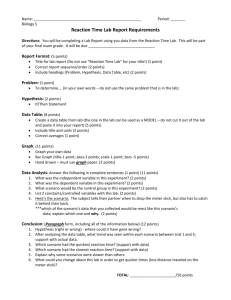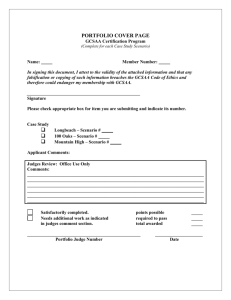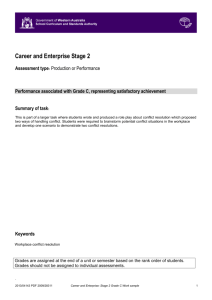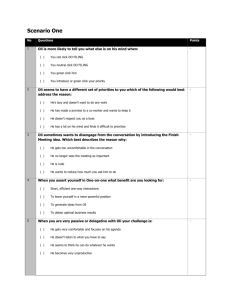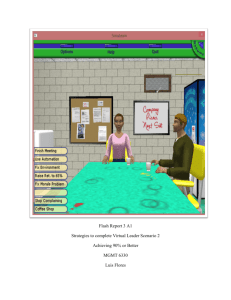White Paper FR3C2 (1)
advertisement
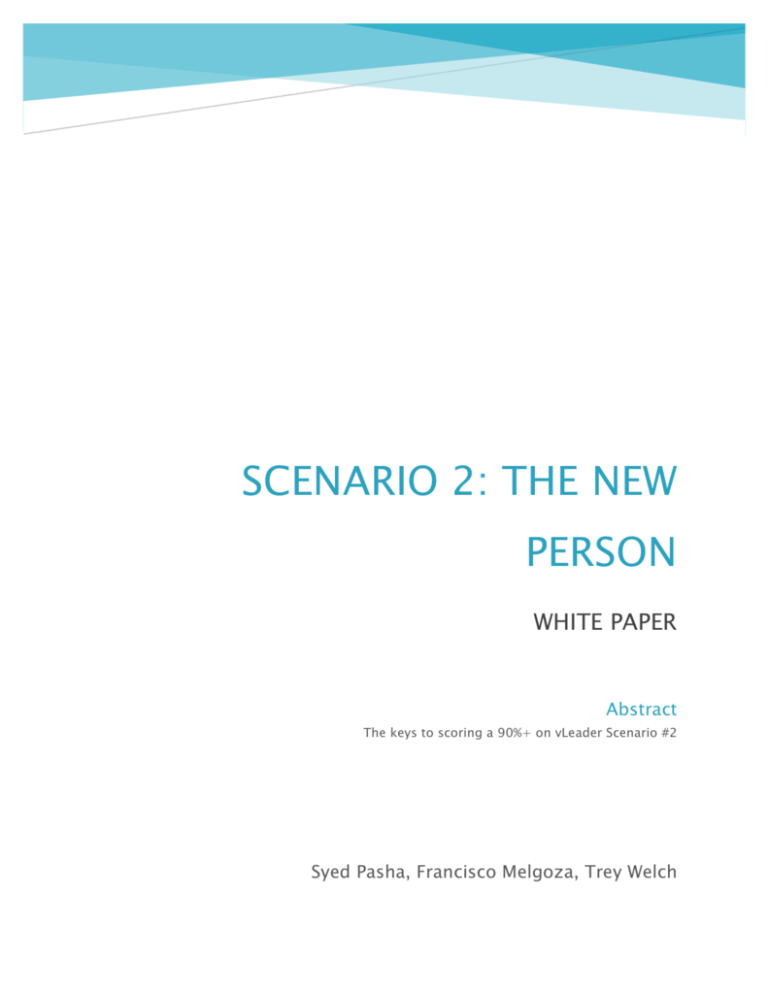
SCENARIO 2: THE NEW PERSON WHITE PAPER Abstract The keys to scoring a 90%+ on vLeader Scenario #2 Syed Pasha, Francisco Melgoza, Trey Welch Scenario 2: The New Person Introduction Virtual Leader is a computer program developed by Simulearn that allows users access to a simulated work environment in which valuable insight into business interactions can be gained. vLeader focuses on the balance of power, ideas, and tension in order to mobilize employees to complete the work you need them to complete. This model (seen to the left) is called the Leadership Framework. The idea is that in order to successfully manage situations you must be able to apply the right amount of power, ideas, and tension given the situation in order to complete the right work and avoid the wrong work. There are two key functions in handling the scenarios as well. The first is observation. By watching the scenario unfold, information can be captured by looking at the body language, the tension of the employee, the sound of their voice. The second is the actual interaction with the employee. How will you respond, how does the employee respond when a new idea is brought up, how to turn the conversation around when it’s headed in the wrong direction. Both of these skills are necessary in the real world applications of these interactions. This paper will discuss the observations and strategies needed in order to solve the scenario and learn from it as well. The graph to the left is taken from the vLeader professional Workbook shows the flow of the necessary parts in order to get things done in our highly complex social system. The higher our emotional FR3C2 Page 1 Scenario 2: The New Person intelligence, the more equipped we are to identify situations as challenges instead of brick walls. Key Pointers Pre Scenario Before we begin the scenario the workbook points out some key information that will be useful to know and understand. First of all vLeader scenarios are not real meetings, not real people, and not real conversations, however, they do encompass the overall behaviors, and general interactions. Our main goal for these scenarios is to not necessarily focus on the specific details of the conversations but the overall ideas being presented. By sifting through the information and finding the important details, we can then strategically sway the conversation in the direction we need. The key is to get the work done that you need done but making it your employee’s idea to do that work. These ideas are all represented in the fundamental frameworks of communication. This approach to communications states that everything we say or do towards either people or ideas will be expressed as supportive, opposed to or neutral towards. We will use the ideas discussed above to solve scenario 2. Scenario 2: The New Person This scenario deals with morale issues in the call center. Quickly we begin to understand that the break room has an oppressive feeling with broken machines and cracks in the walls. As the manager we have the power to change the FR3C2 Page 2 Scenario 2: The New Person situation however, we have not built the respect or attention of the employees yet. We have been tasked with changing the morale as well as having senior leadership buy into your plans as well. As we get into scenario 2, you will notice that things get started quickly. Your task? To manage the call center group, increasing the retention rate from 40% to 65%, and put an end to the complaints from employees about being replaced by technology due to the new automated system. This is not an easy task however, with our firm understanding about the leadership model presented above and our high emotional intelligence, we will be able to tackle the issue at hand. Our goals for the scenario will be to attain “Master Play" Level. That will be achieved by doing these things: FR3C2 Page 3 Scenario 2: The New Person -Score of 90% or higher -80 turns or less -dialog % of 35% or less We must focus on getting the environment fixed, fix morale, crisis looming, automation, and raising the retention rate. Start the conversation of with the fixing the morale problem. This will be an easy solution to pass since Oli and Rose both Keys to Success: agree on fixing morale as being a major base to the success of the company. Try not to say much in this just give non- - Try your best to follow this order: verbal cues (right mouse button as shown to the left) to affirm your backing of this idea once its brought up. The next thing - to attack will be the automation system. This will usually - prompt Oli to come up with the hidden idea of crisis looming. - This idea is one of the key ones that needs to be discussed - and passed. Again the key is to keep the group on this task and to use non verbal cues to convey your satisfaction with the idea. If you have to, make sure Rose knows you are happy with her by sliding her bar to the right a little, she will loosen up a bit and will become open to the idea of fixing the crisis that's looming. The next idea to tackle will be to fix the FR3C2 Page 4 Scenario 2: The New Person environment. Oli and Rose both agree that it is a good idea and you should have no issues getting this passed them. Every once and a while at this stage, you start losing focus of the two participants. They may want to end the meeting or talk about something else. Keep them focused on the task you are talking about unless they bring up another important topic with positive comments. The next step is to bring up the 65% retention rate only if Oli and Rose are in agreement towards one another. By constantly giving non-verbal and verbal cues you can influence them to work together. This idea takes a while to get through but it is the biggest goal for the business. The final idea that needs passing is the automated system. This needs to be done close to the end and you have to present this one as something you will take care of by moving your sliding bar to the right on the idea. This strategy will keep you in the master level as long as you use mostly non-verbal cues during the meeting. When you need to use your verbal cues are towards the end when the last two ideas are being pitched. Post Assessment Why did this work? Because we had a plan and we followed it. We needed the 65% retention idea passed as well as the employees grumbling brought to a minimum. We also needed everyone on board with the automation as well. We were able to achieve all of our goals while managing to make everyone happy and FR3C2 Page 5 Scenario 2: The New Person excited about the upcoming changes. We empowered and motivate Oli and Rose to be proactive with the future changes and got them on board with our overall plan of improvement. We gave up a little in terms of fixing up the break room however, it was a necessary in order to change the oppressive culture that only focuses on shareholders instead of the employees. The basic rule of economics is that people will act in their own self interests. This is true for employees that you are trying to manage so the goal is to align each employee’s interests and motivations with your goals. FR3C2 Page 6 Outcome Directed Thinking Map Scenario 2: The New Person Do research on how to motivate both Rosa and Oli enough to get their buy in for every scenario. MOTIVATIO N Everyone in the team share ideas and take help from each other to reach the goal of 90%. PO SITIVE OUTCOME All members of the team understand the strategies and tactics behind creating motivation. STATEMENT BARRIERS Share ideas Getting Rosa’s Understand with Rosa with buy in FR3C2 Rosa’s needs statistics Oli’s of Listenlack to his Work with Oli experience concerns and by improving offer solutions. Raise Createretention an actionPage 7 Show old results rate 65% plan to with Rosa’s when ret. was at and Oli’s help

